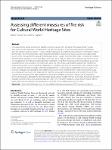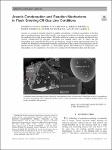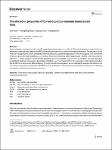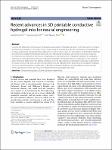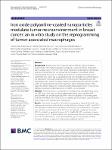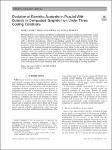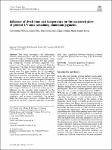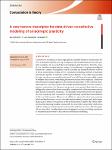Search
Author
- Osman, Ahmed I. (5)
- Daqing, Ma (3)
- Jorgensen, Ed (3)
- Li, Yan (3)
- next >
Subject
- kinh tế (26)
- Economics (12)
- programming (10)
- XRD (10)
- next >
Date issued
- 2020 - 2025 (2129)
- 2010 - 2019 (129)
- 2000 - 2009 (9)
- 1999 - 1999 (1)
Has File(s)
Search Results
This study aims to assess whether two publicly available sources of fire threats to 346 Cultural World Heritage Sites across Europe substitute or complement each other. By doing so, a novel measure based on information from the UNESCO periodic report II is created and benchmarked against the European forest fire information system (EFFIS) index. The UNESCO periodic report shows that forest fires are perceived as an actual or foreseeable hazard by 40% of the management of Cultural World Heritage Sites in Europe. When the EFFIS index is linked to the UNESCO World Heritage database, it occurs that 48% of these sites are at high risk of fire, 31% at medium risk and 21% at low risk. Results based on Probit and Fractional Probit estimations reveal that the perceived fire risk relates to s... |
Arsenic is a common impurity element in sulfide concentrates. It tends to accumulate in the flue dust of smelting furnace due to the volatility and internal circulation of the flue dust practiced in the smelting-converting process chain. The only outlets for arsenic are anodes and discard slag. Arsenic condensation in dust-free conditions was studied below 800 °C where the gas atmosphere was controlled by SO2-air-N2 gas mixtures. Based on these experimental results, we confirm the kinetically constrained formation mechanism of the arsenic-containing dust, and its speciation into metallic, oxidic (III, V), and sulfidic species. The influences of temperature and atmosphere on the speciation of arsenic were compared with industrial data and discussed. |
Various doping concentrations of boron (B)-doped germanium nanocrystal (Ge NC) films were prepared using the plasma-enhanced chemical vapor deposition (PECVD) technique followed by thermal annealing treatment. The electronic properties of B-doped Ge NCs films combined with the microstructural characterization were investigated. It is worthwhile mentioning that the Hall mobilities μHall
of Ge NCs films were enhanced after B doping and reached to the maximum of 200 cm2 V−1, which could be ascribed to the reduction in surface defects states in the B-doped films. It is also important to highlight that the temperature-dependent mobilities μH(T)
exhibited different temperature dependence trends in the Ge NCs films before and after B doping. |
In the growing area of neuromorphic and in-memory computing, there are multiple reviews available. Most of them cover a broad range of topics, which naturally comes at the cost of details in specific areas. Here, we address the specific area of multi-level resistive switching in hafnium-oxide-based devices for neuromorphic applications and summarize the progress of the most recent years. While the general approach of resistive switching based on hafnium oxide thin films has been very busy over the last decade or so, the development of hafnium oxide with a continuous range of programmable states per device is still at a very early stage and demonstrations are mostly at the level of individual devices with limited data provided. On the other hand, it is positive that there are a few d... |
Recently, the 3D printing of conductive hydrogels has undergone remarkable advances in the fabrication of complex and functional structures. In the field of neural engineering, an increasing number of reports have been published on tissue engineering and bioelectronic approaches over the last few years. The convergence of 3D printing methods and electrically conducting hydrogels may create new clinical and therapeutic possibilities for precision regenerative medicine and implants. In this review, we summarize (i) advancements in preparation strategies for conductive materials, (ii) various printing techniques enabling the fabrication of electroconductive hydrogels, (iii) the required physicochemical properties of the printed constructs, (iv) their applications in bioelectronics and ... |
Breast cancer is the neoplastic disease with the highest incidence and mortality in the female population worldwide. Treatment remains challenging due to various factors. Therefore, it is of great importance to develop new therapeutic strategies that promote the safe destruction of neoplastic cells without compromising patients' quality of life. Among advances in the treatment of breast cancer, immunotherapy stands out as a promising trend. Recent studies have demonstrated the potential of iron oxide nanoparticles in promoting the reprogramming of M2 macrophages (pro-tumor phenotype) into M1 macrophages (anti-tumor phenotype) within the tumor microenvironment, resulting in potent antitumor effects. In this study, the effect of polyaniline-coated iron oxide nanoparticles (Pani/y-Fe2O... |
shrinkage defects are common problems in industrially produced metal cast components. Local density changes occur during freezing, which demand material transport between parts of the casting, often involving flow of liquid through partially solid regions. Cast alloys typically freeze with a dendritic morphology, which large interface against the liquid restricts liquid flow. Recent research also indicates that this dendritic structure has an impact on the mechanical properties of the final material. For these reasons it is important to understand and predict the evolution of this structure through the solidification of cast alloys. In this work, the evolution of the dendritic austenite structure is investigated in a near-eutectic compacted graphite iron solidified under three diffe... |
The TiO2 photocatalytic coatings’ most important properties are durability and photocatalytic activity. Those features form a basis to determine its degree of usefulness. In this study, the self-synthesized amorphous TiO2 powder was used for low-pressure cold spray photocatalytic coatings. Two strategies were adopted to change the surface properties, which can influence the mechanical properties of the coatings: (I) reduction of the scanning step and (II) filling the depressions in the already sprayed coating with the second layer. The coatings surface topography (measured by roughness and waviness) results showed that the first strategy makes coatings thicker, with a more uniform surface. The second strategy leads to obtaining more rough surfaces with no significant change in the t... |
This study investigates the relationship between measured gloss and the microstructure of printed UV-inks containing aluminum pigments. Using a laboratory flexo printing machine, UV-inks containing leafing-type vacuum metallized pigments were printed onto Chromolux paper and primed MultiArt Gloss paper. The time between printing and curing of the ink (dwell time) was varied between the experimental runs. For some samples, hot air was applied onto the uncured UV-ink during the dwell time. The influence of heat (hot air) and dwell time on gloss and the topography of the pigment layer as well as the influence of the substrate was investigated. Roughness and waviness data were obtained using a confocal microscope (Sensofar PLu Neox), gloss measurements were obtained using an IQ-S gloss ... |
Constitutive modeling of anisotropic plastic material behavior traditionally follows a deductive scheme, relying on empirical observations that are cast into analytic equations, the so-called phenomenological yield functions. Recently, data-driven constitutive modeling has emerged as an alternative to phenomenological models as it offers a more general way to describe the material behavior with no or fewer assumptions. In data-driven constitutive modeling, methods of statistical learning are applied to infer the yield function directly from a data set generated by experiments or numerical simulations. |

